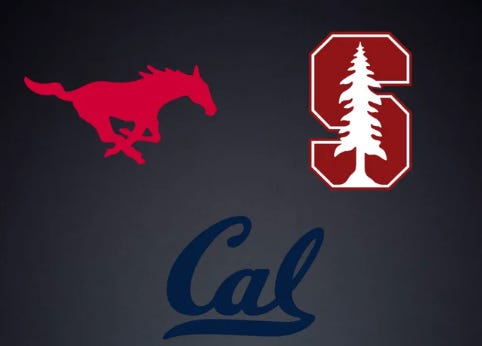ACC discusses adding Cal, Stanford at reduced shares, SMU to forego revenue for seven years
The ACC is back to talking about adding the California Golden Bears and Stanford Cardinal.
Ross Dellenger of Yahoo now has financial details:
The ACC’s television contract with ESPN includes a pro-rata clause requiring the network to increase the value of the deal by one Tier 1 share for every new member — believed to be about $24 million a share, or about 70% of a full ACC share, which includes Tiers 1-3.
The ACC would stand to earn about $72 million in new money with the three expansion shares. Cal and Stanford have agreed to each take about 30% of the $24 million share, or roughly $7-10 million. After Cal and Stanford’s share and travel costs are off-set (roughly $1-2 million per school), the ACC stands to earn at least $30 million in revenue to re-distribute, likely through an incentive pool based on athletic success.
The California Golden Bears and Stanford Cardinal and the ACC keep dancing! Pete Thamel of ESPN reports that the discussions are back on, and SMU is in it too.
Sources: The potential additions of Cal, Stanford and SMU to the ACC are again under serious consideration by the ACC. A small group of ACC presidents met Wednesday morning to discuss financial models that would come with the additions.
Thamel also reported that the biggest concession is as expected, revenue share, and likely exercise cliffs over time.
Those models are are expected to include significant financial concessions from the school that will be added.
There’s expected to be a pool of money created from these additions, and the ACC presidents are discussing how the money would be split. The mechanics of that are still to be worked out, including a performance pool for success initiatives.
Thamel stated that one more vote needs to be swayed:
More meetings are expected this week. Just one vote is needed among the block of UNC, N.C. State, Clemson and FSU to get the three new schools in, assuming all the yes votes are in agreement with the financial arrangements. A realistic timeline for a decision is about one week.
These success initiatives might sway the no votes, as Clemson and Florida State are projected to be more successful year over year.
Thamel also mentioned SMU is back in the conversation as it appears the money-rich donors of the Mustangs are willing to cover costs to get them into a major conference.
The concessions expected from SMU include a willingness to take no broadcast media revenue for the first seven years they are in the league. Stanford and Cal would both receive the same share, which will both be reduced but different in form than SMU's concessions.
Mike Silver said that the conference invites are centered around football and basketball, and Olympic sports might have to recalibrate.
The Cal-Stanford ACC talks are centered around a football-basketball only model, I am told. It's unclear what would happen in terms of the other sports (and there are many, and they are GOOD) and conference affiliation. Right now economic survival is the initiative.
Nicole Auerbach reports that the ACC is looking at adding all sports.
In case it's not obvious to all, Stanford and Cal would be joining the ACC in all sports if added.
Cal and Stanford might know their power conference fate in a coming week. Changes are coming to each athletic department for sure. How dramatic those changes are hinges on a major conference invite.



I for one am stoked. This was the next best option to a B1G invite, and though I admit I have many suspicions as anyone about the impact of travel on our competitiveness, you can also make a case that we'll have a better opportunity to compete and succeed in the ACC than we would in the B1G. First off, not enough has been made of the fact that this is just a massive, massive upgrade for mens bball -- like getting an SEC invite in football. Calford are now the first and only teams on the west coast that can guarantee trips to Duke/UNC, Syracuse, Louisville, etc. year-to-year. We'll absolutely be a player in west coast recruiting once again. Football-wise we'll be the featured 7:30pm ESPN game every other Saturday evening like clockwork. And we'll have a path to the playoff in a conference where 15 of the 18 schools are roughly our competitive equivalent. Culturally, these schools make sense and add value. I want to travel to all of these cities/campuses. While we will be behind from $ standpoint, even the most cynical part of me (roughly 98%) believes there is a plan to close that gap between our own finances and the competitions'. It would make no sense to go through this otherwise. And though this has been painful and will continue to be as valued programs are cut, the message has been received that we need to be competitive again--not only at the campus level, but also at the Regents level. That can't be understated. It's the beginning of a new age.
Avi, kudos and thanks for keeping these posts coming, despite the dearth of actual news. Its nice to have a place to discuss the situation.